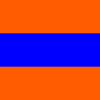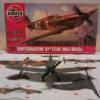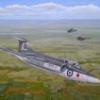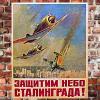Search the Community
Showing results for tags 'Novo'.
-
Joining you with this nightfighter from Novo. . Acquired from a colleague who trades in toys for £2.50, I get first dibs at the models. This in my Nightfighter offering, with an intent to try a tank killer, and ship killer specialists, if I have time.
-
On 5 May 1942 an advance party arrived at Chelveston from the Air Forces Experimental Establishment Detachment from Ringway in connection with the carrying out of specified work on the development of towing troop-carrying gliders. The remainder of the party arrived – according to official records – whenever the weather was fit for flying. On 3 June a Lockheed Hudson was towing two Hotspurs when one disintegrated in mid-air north of Raunds. Fortunately, both the crew survived. The AFEE left Chelveston on 31 August 1942.
- 12 replies
-
- 20
-

-
Vickers Vimy IV, 502 (Ulster) Squadron, RAF Aldergrove, Co. Antrim, circa 1928 - 29 Converted from the Frog Trans-Atlantic 'Trail Blazers' Alcock & Brown kit Not a show winner by any means, but not too bad from 6ft
- 24 replies
-
- 42
-

-

-
Hello all! I am continuing with my theme of building old model kits. This time it is the Novo (ex-Frog) Percival Proctor IV. I have built it out-of-the-bag, with the probably understandable exception of the transfers...I was going to save it for the potential Frog Group Build, but I was a bit impatient! I added seatbelts from tape, a piston in the engine louvre and drilled out one intake as the sum of improvements. The colour scheme is entirely fanciful, but if anyone says the serial is for a Shorts Tucano I will say 'You are right!' All the transfers came from the surplus left over from a Tucano, and I thought the blue cheat lines showed off the Proctor rather nicely. The paintwork is brush-painted, Revel 90 Acrylic Silver in the main, but the engine cowling is Mr Metalizer again brush 'painted' (i.e. read scrubbed on with an ancient brush then buffed with a cotton bud) and it gives a nice bit of contrast. I was very surprised at the fit of the components, I needed to use filler only on the wing-roots and the upper forward cabin roof. The transparencies could have been better, or I could have used the Falcon Vac-form set. I think I could also have dealt with some sink marks a bit better. The aerial wire was EZ-Line. Thanks for looking, all the best, Ray
- 29 replies
-
- 49
-

-
Having entered service just too late for WW2, the Hornet featured a similar wooden construction to the Mosquito, and served predominantly with the RAF in the Far East. It saw service during the Malayan campaign, flying with 33, 45, 64 and 80 squadrons, before being withdrawn and retired in 1956. As well as the Far East, the Hornet also equipped three squadrons in the UK, numbers 19, 41 and 65 sqns at Church Fenton, flying firstly in the long range fighter role then converting to ground attack as more Meteors became available. No. 19 sqn operated Hornets from October 1946 until January 1951. The Novo kit is basic but as far as I'm aware still the only 1/72 Hornet available? This one was built oob, except for a tiny bit of scratch building of the pilot's front console and having to source spare decals and serial numbers as the kit ones dissolved and were completely unusable. Although it's called finished, I'm still looking for the 19 sqn tailfin markings and the square marking on the left side of the fuselage behind the 'QV' code.
- 24 replies
-
- 20
-

-
Yes, this is going to be just like the old days, back from the shops and built over the weekend Terrified of desolving Decals but really looking forward to this cheers Pat
- 40 replies
-
- 6
-

-
Another ancient Novo kit, courtesy of ebay! Hopefully I can bash it into a shape resembling an early 1950s Hornet. This is probably my last one until after we move house, then I can start on more Vulcans and Victors! Looks like the usual thick Novo plastic, but the overall shape seems nice. I'm far from a rivet-counter so as long as you get the feeling of early 50s piston fighters when you look at the model that's good enough for me. I might need some new/extra decals though, these look like they may break up. The serials look a bit 'heavy' too, I might use the Xtradecal letters instead.
- 38 replies
-
- 11
-

-
Hi all Amongst quite a few other projects I have been beavering away on this for a while. This is a lovely little kit and goes together well apart from some fettling on the Canopy which was a bit of a so and so. The interior is as per the kit apart from an IP and painted on seatbelts . I have re secribed the very few panel lines. The Dome for the ring ariel is from an AZ Models Airspeed Oxford and the ring ariel is made of 5 amp fuse wire. The antenna wire is invisible thread with Cyano isolators. The prop is from a PM models Beech C45 Expeditor as the Kit one was missing. The Exhaust was home made. The Kit decals were a nightmare and completely disintegrated when they were dipped in water. I would like to say a big Thank You to Beard for coming to my rescue with some spares. I would also like to thank everyone for their kind comments on the WIP. Thank you for popping by. All the best Chris
- 12 replies
-
- 26
-

-
Hi all I thought whilst I was posting on the other two aircraft I thought I might as well post on this one. I have got to say I have really enjoyed this one. I added an IP and some seatbelts and have rescribed the panel lines and the propeller is from the spares box with the kit spinner as although the kit was sealed in the poly bag with card header it looks to have come out one of the airholes in the bag. The only problem are with the kit is the main canopy which did not fit at all well and I used some Laser Glaze to complete it. I rubbed off the framework and polished for what seemed like ages but could not get it much better so it will have to do. I am doing the aircraft that comes in the Kit. Thanks for looking All the best Chris
- 46 replies
-
- 29
-

-
The sleek and angular Fairey Delta 2 was the first aircraft to exceed 1,000 m.p.h. in level flight. Tailless and with a distinctive needle nose, it was designed by Herbert Chaplin of the Fairey Aviation Company. The F.D.2 was created to meet a British government requirement for an experimental to investigate transonic flight – flight at or near the speed of sound. The two intakes for its Rolls-Royce Avon afterburning turbojet were in the roots of its mid-set, slender delta wing, which had 60 degrees of sweep on its leading edge. Because the aircraft adopted a nose-high attitude on its landing approach, it was designed with a nose capable of drooping by 10 degrees. Test pilot Peter Twiss took the F.D.2 beyond Mach 1 on 28 October 1955, reaching Mach 1.56. On 10 March 1956 two measured runs were undertaken at 38,000ft. achieving a mean speed of 1,132mph (Mach 1.73). This was an extraordinary 38% faster than the previous record, set by a North American Sabre fighter only seven months earlier. A second F.D.2 was used for aerodynamic research in the development of Concorde.
- 16 replies
-
- 24
-

-
This was included in a box given to me. One was on the runners and this one had been started and some parts were missing. I had to scratch the clear part of the canopy, the wing fences and some of the undercarriage doors. No decals with it either, so I used these Lightning markings.
- 10 replies
-
- 22
-

-
What we're gonna do right here is go back. Way back. Back into the early 1960s. And judging by the standard of the decals and plastic I don't think the kit is much newer! I've always had a fascination with the Javelin, from my favourite RAF era, mid 50s to mid 60s, when aeroplanes were real, with proper colours and markings and we had more than three squadrons of fighters. I'd love to have seen these beasts howling over Norfolk. So, the basic kit: And it is quite basic, I want to try this one out before I do the much better Airfix kit. The decals are terrible. Not only do they look basic but they appear to be cracking, I think they'll just break up on soaking, so to the aftermarket I will need to go. Either that or use the Airfix 64 sqn ones and then aftermarket decals on the newer kit. Does anybody know of a decent set of 1/72 Javelin decals? What on earth is all this!? ... Hoping to get some inspiration for markings from this superb book. Anyone have any advice, especially on the decals?
-
A last minute decision to use the kit decals after the Model Alliance set on eBay crept beyond £12! The kit decals were slightly cracked through age, but fortunately didn't break up in the water. After serving with 25 sqn, XH905 flew in 33 sqn markings until November 1962 when the unit was renumbered 5 sqn and moved to Geilenkirchen in Germany. It was based here until 1966 when the Javelin wing disbanded. It's remarkable how short the service lives of some front line fighters were in those days! I built this one OOB apart from adding the tiny aerial on the tailplane, and painting the control panels as the decals didn't include any. Colours are satin DSG spray, Tamiya XF-81 green and silver spray from Halfords (!). The kit was generally good apart from excessive flash on some sprues, but fitted together reasonably well for the most part, I just needed a lot of filler for the wing roots. So here she is, Javelin FAW.9 XH905 of 5 squadron ... I'd love to get better at this (more realistic looking models), so all comments and ideas for improvement welcome!
- 14 replies
-
- 22
-

-
Hi all. I have just made a start on the old Frog/Novo DH60 Gypsy Moth in the green/silver colours of Amy Johnson's aircraft. My question is, what is the best match for the green of the fuselage? I have only managed to find mention of 'dark green' but this seems too dark in relation to pictures of the real thing. Any ideas?
- 3 replies
-
- Gypsy Moth
- Novo
-
(and 1 more)
Tagged with:
-
I didn't consciously decide to go on an old Frog kit building frenzy. Or, at least I don't think I did. Regardless, here's another one. This time it's the 1977 Novo release of the 1974 Frog Lavochkin La-7 in 1/72nd scale. I've built it straight out of the hang card bag with the exceptions of a total rescribe with recessed panel lines, the addition of a bit of plastic card to block off the main wheel well and employing a very nice set of Authentic Decals printed in, rather ironically, Russia. I cannot speak to accuracy as I didn't bother to check but it looks rather like the La-7 photos I've peered at. It's a simple kit but pretty cleanly molded and didn't require a great deal of fettling or putty to get it paint ready. I went with Vallejo Model Air colors for the camo and Tamiya for the rest. Both always go on very well, especially over Stynelrez primer which seems to bond so well to the plastic and the paint to it. Oh, and I used some Bare Metal Foil for the strips around the cowling. I also tried the artist oils wash technique for the first time. It's a bit subtle on this particular job, maybe used too dark a brown, but I quite like the idea and will be using it more often for sure.
- 10 replies
-
- 32
-

-
Another of the classics has been finished. The kit came in just a stapled plastic bag with the vintage instruction sheet in Russian. The kit had no decals, so I had to conjure something up using spares. Of course it is historically unaccurate therefore! Actually, this is the first Spitfire I ever built!
-
I picked this up for a fiver on Ebay. As with most of the kits I've built recently, I have no idea what I'm 1 doing, or how it will turn out - except that I'll do my best too not squash the damned thing. The plastic is more like the stuff Hornby & Peco make sleepers out of for their railway track - so I have no idea what glue works with this. Looking at the few attempts at this kit on Flickr, the wooden frame is certainly a little thick, so one of my first tasks was to start filing it down a little. This was going well until one of the struts pinged off & got swallowed by the carpet monster, so at some point I'll have to replace that with something out of the spares box. The kit is certainly very basic & also fairly inaccurate - the number of struts making up the rear section of the fuselage doesn't match photos of the real thing - probably because they're so thick. I've decided to use Vallejo "aged white " for the fabric colour. Most pics of the real thing that I've seen show the shadow of the wing structure through the fabric, so I'm using revel reddish brown to mark out the frame inn the hope that it will show through the white without being too dark. So long as I can get it all together in a reasonably tidy fashion I reckon rigging it with ez-line will make look reasonably good, even if it isn't all that accurate. after three short evenings here's where I've got to... I reckon it'll take about two weeks to complete using my ham-fisted methods.
-
MB414 of the Fighter Interception Unit & RNAS No. 746 Squadron, Wittering, April – August 1944.
-
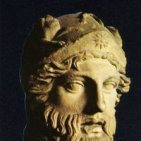
Bristol 138A Prototype with wheel covers
Xantippos posted a topic in Ready for Inspection - Aircraft
Here I comeback to the forum after a long time with this kit. Although not a wartime aircraft, it is one of the closest things you can find that actually didn't fought but looks like if it would have had. The main thing that separes these kit from the usual is; modified pilot to resemble the actual pilot who achieved the records, with a white suit, resembling a pulp fiction astronaut, and I sculped with putty the wheel protections on the wheels, which I think gives a great style, besides the chroming of the nacelle. This has been a family build - built by my father, wheel protections and pilot made by my brother, and painted, chromed and decalled by myself. I have made also a full review; http://toysoldierchest.blogspot.com/2015/01/frog-novo-bristol-138-research-plane.html -
I did this kit as an exercise in airbrushing doing the camouflage freehand and the underneath as a masking exercise. I also bought some galeria matt varnish to try as well. The decals come from a P40 decal sheet as the novo ones didn't age at all. The wheels got lost somewhere in the past and as the wheels were jettisonable i didn't put them on. S on the nose comes from an airfix P38 and the serials are not on as I dont know which ones the aircraft carried but not to worry Normal proviso best seen from 5ft away BTW I used the £4 airbrush that was touted on here a few months ago Rodders
-
I come a bit late to the build as I was saving up my project for my summer holiday, which started on 13 July and which I have only just come back from. With my very intermittent internet access I decided to save my updates until I got home, and here is the first of them... I took as my subject FR901, a P-51A Mustang (Mustang Mk II), used for long-range ferry tank trials. It is illustrated in "The North American P-51 Early Mustang" and on the web, including some very fine photographs on Pozefilms.de. The pictures date from July 1943. For my base kit I used two reboxings of the venerable Frog P-51A/Mustang MkII kit, one from the limited Novo release, and the other from an unidentified Eastern European manufacturer. I cross-kitted, using the main components from the no-name kit (which whilst softer in detail had fewer sink-marks than Novo) with the latter's markedly crisper detailed parts. To supplement this base I also purchased Quickboost exhausts (which I will not now be using as I do not think they are correct for this particular machine) a Pavla canopy and some paper instrument panels. The cockpit fittings came from MPM's P-51 kit, where they had been rendered superfluous by the resin cockpit parts provided. I had already built another iteration of the FROG/Novo kit as FR919 of No. 2 (Army Co-operation) Squadron, and retained and reused the instructions from this kit to support the build. I chose these kits as they were cheap and readily available and I knew that, although basic, they made-up well. The two base kits together cost around £8, and I got a CBI-theatre P-51A out of the remaining parts, plus leftover decals from when I made FR919. Aftermarket parts came to around £5.50 excluding postage. Having gathered the necessary parts, my first step was to annotate my instructions with the changes required, to write myself out a step-by-step illustrated build guide and to begin measuring-up the alterations required to the inboard wing leading edge to bring it to the correct profile. I also took the opportunity of researching the detail of the wheel wells.
- 27 replies
-
- 2
-

-
- Mustang II
- FROG
-
(and 2 more)
Tagged with:
-
HMS Hero Detail Set 1/500 Atlantic Models Even though a model has been on the market for some considerable time, there is still a need for some to superdetail it. This is particularly so for the Frog/Novo 1/500 HMS Hero, which whilst it hasn’t been in production for some considerable time, I’d imagine there are a few snuck away in stashes across the globe. Well, now’s the time to dig them out and get building as Peter Hall has released this etched brass sheet of detail parts to bring it bang up to date with some super fine detail. Detail set ATEM 17: As stated above this detail set comes on a single sheet of etched brass that is somewhat sturdier than the miscellaneous sets reviewed here, yet still very fine and foldable. Relief etching has been used where necessary which helps give some depth to the parts. Along with the standard fittings, such as railings, vertical ladders, inclined ladders, and anchor chain, there are loads of more specific items on the sheet. Each gun turret receives a complete replacement shield plus B and X turrets can be fitted with the flare rocket rails. New quad machine gun mounts are included as are new depth charge throwers, which will require a piece of 20thou rod to be used to represent the depth charge. The AA gun platform has new supports for the side wings and the rear section and there is a replacement depth charge rack and TSDS stern gantry for the quarterdeck. Additional details for around the depth charge racks are the loading davits and TSDS winches. Also included are a new 4” AA gun and platform, Type 286 radar array, Type 285 Yagi array, bridge rangefinder platform, bridge wing support structures, semaphore arms, bridge windscreen and optional bridge canopy. The foremast receives new yard arms, whilst optional main masts are provided with additional supports and, in the case of the early fitment, a new HF/DF array. Not only do you get diagrams to show where parts are placed, but a very useful written narrative, showing how other items are scratchbuilt for the etched parts to be fitted to. The ships boats are fitted with a complete set of oars, thwarts/gunwales, and a new rudder, these can then be attached to the new davits which include downhauls. Finally there is a new accomodation ladder for those modellers that would like to build the ship in a diorama setting. Conclusion This is yet another brilliant and very useful sheet of etched brass. It doesn’t appear to be overly complex so should be good for a beginner to etch work, with the plus side of bringing an old model up to date with the sort of detail it deserves. Highly recommended Review sample courtesy of Peter Hall of
-
- Atlantic Models
- 1:500
-
(and 3 more)
Tagged with:
-
Wessex HAS1 815 Naval Air Squadron, HMS Ark Royal, 1962 Frog / Novo 1/72 kit This one was in the attic for more years than I can remember. What I can remember is buying the Frog kit when I was at school in the mid 60s and rushing home to built it. That one’s long gone now, and this build is based on the Novo version. This was almost an OOB type of build despite the age of the moulds – I decided not to re-scribe for once and to do a very limited interior re-furb. I added a bit of detail to the main and tail rotor hubs but that was about it really. Finish is Extracolour RAF Blue Grey and Humbrol Gloss Yellow over a Halfords white primer base, with a top coat of Humbrol satin varnish. Decals were based on a couple of old Modeldecal sheets, but roundels and ‘Royal Navy’ were replaced with more recent decals as the originals had yellowed just a bit too much to use.
- 28 replies
-
- 12
-

-
Good afternoon colleagues. One of my early operations. But the model is seldom built by modellers. Therefore decided to show. Blackburn "Shark" II K5609 №684, the 821Squadron, aircraft carrier HMS "Courageous" 1936.
-
I am currently in the process of building an old Novo La-7/S-97 kit which I picked up for £2 at the Old Toy Museum at Bletchley Park a few weeks ago. Leaving aside that it has a few bits missing, being a lazy modeller I am slightly foxed by the paint colours given on the header card. For the version I am building, an S-97 of the Czech Mixed Air Division Czech Air Force,Slokavia 1945, it gives Matt White, Matt Black, Matt Dark Blue, Matt Red, Matt Dark Grey, Matt Light Blue, Matt Brownish-Green and "Stained Natural Metal". Is there any ready-reckoner I could use in order to relate these to my favoured Humbrol paints, or could some kind person suggest some acceptable matches/mixes? (It is particularly the last six I am after advice on.) Many thanks in advance. More on the kit here: http://www.novokits.ru/index.php/kits/11-novo-novoexport-kits/75-novo-1-72-lavochkin-la-7.html
- 2 replies
-
- Novo
- paint schemes
-
(and 3 more)
Tagged with:



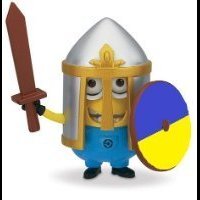
.thumb.jpg.ba34a9f6ddce411193946dbdcc7b5fe8.jpg)



